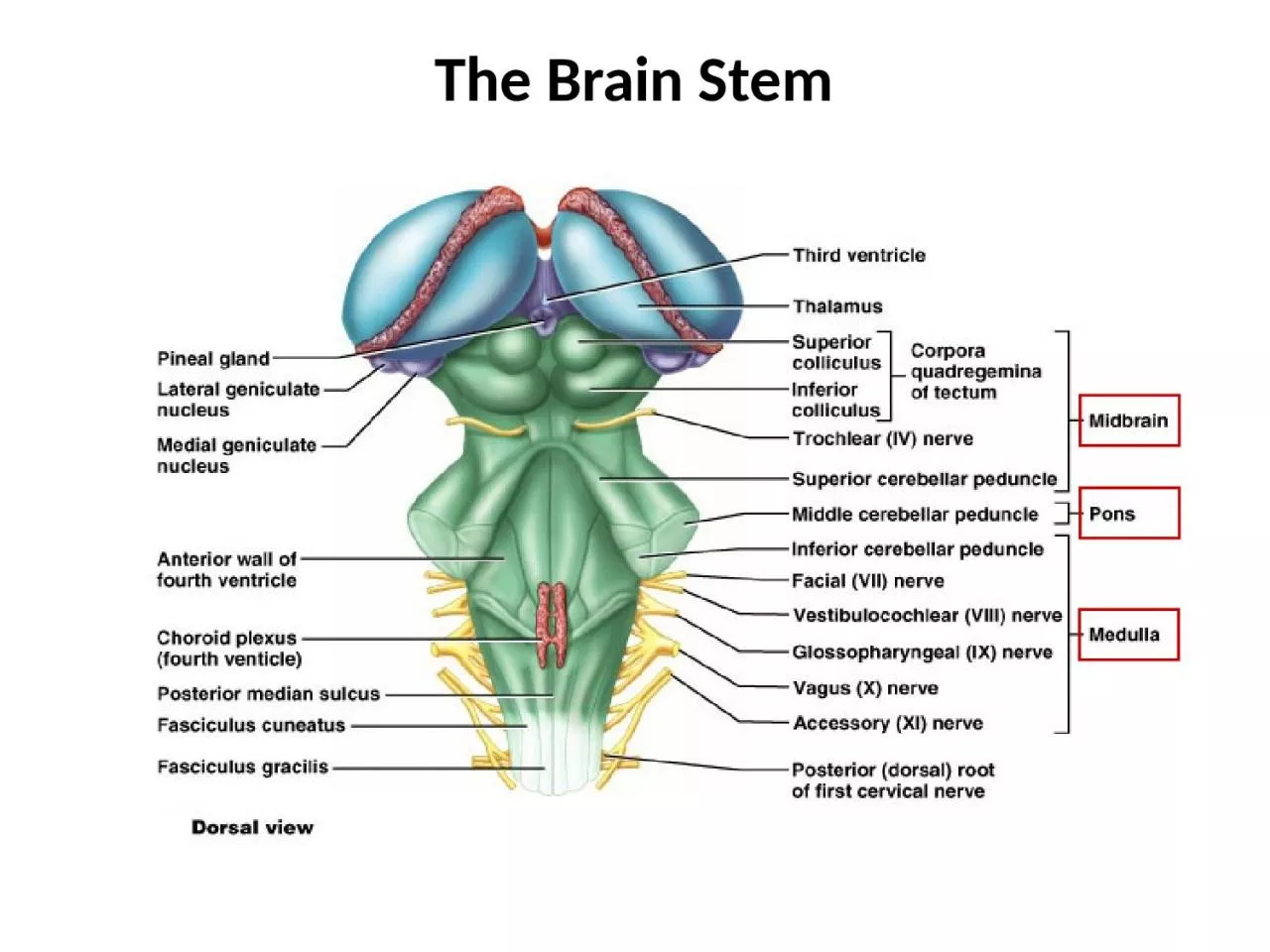

Midbrain Pons Medulla Oblongata Midbrain Corpora quadrigemina four bodies 2 pairs Superior colliculi gt nuclei that act in visual reflexes vision Inferior colliculi ID: 1046340
Download Presentation The PPT/PDF document "The Brain Stem The Brain Stem" is the property of its rightful owner. Permission is granted to download and print the materials on this web site for personal, non-commercial use only, and to display it on your personal computer provided you do not modify the materials and that you retain all copyright notices contained in the materials. By downloading content from our website, you accept the terms of this agreement.
1. The Brain Stem
2. The Brain StemMidbrain, Pons, Medulla Oblongata
3. MidbrainCorpora quadrigemina= ‘four bodies’ (2 pairs)Superior colliculi=> nuclei that act in visual reflexes (vision).Inferior colliculi=> nuclei that act in auditory reflexes (sound).
4. The Cerebellum – superior viewLocated dorsal to the pons and medullaConsists of two cerebellar hemispheresFolia
5. Functions of CerebellumLocated dorsal to the pons and medulla1) Controls postural reflexes: - coordinates rapid, automatic adjustments of muscles in body to maintain equilibrium. 2) Produces skilled movements:- - implements routines for fine tuned movements. Refines learned routines until the action becomes routine.
6. * Thick tracts connecting the cerebellum to the brain stem* Superior, Middle and Inferior Cerebellar Peduncles* Fibers to and from the cerebellum are ipsilateral - run to and from the same side of the body
7. Pons* Contains the pontine respiratory centers.* Contains the nuclei of cranial nerves V, VI, and VII
8. The Medulla contains:Much of the reticular formationNuclei influence autonomic functionsVital centers of the reticular formation:1) Cardiac Control Center2) Respiratory Control Center 3) Vasomotor Control CenterAlso contains centers for hiccupping, sneezing, swallowing, vomiting and coughing.
9. The SkullProtection of the BrainCranial MeningesCerebrospinal FluidBlood-Brain Barrier
10. 1. Dura Mater - Composed of two layers:a) Periosteal (Endosteal) – outer layer attaches to bone.b) Meningeal – inner layer, closer to brain.Cranial Meninges - 3 layer protective membrane(These two layers fused, except to enclose the dural sinuses)3. Pia Mater - delicate, follows convolutions.2. Arachnoid Layer - ‘spider’ web-like layer.Composed of dense irregular connective tissue.Composed of loose/fibrous connective tissue.Composed of an outer collagen layer, & inner epithelial elastic and reticular fiber layer.
11.
12. Subdural space Potential space between dura and arachnoid mater.Cranial Meningeal Spaces Epidural space Potential space superior to dura. Subarachnoid spaceFilled with CSFContains the blood vessels supplying brain.
13. The Sinuses
14. Roles of CSF:Cerebrospinal Fluid (CSF)* CSF formed in the choroid plexuses in ventricles of brain1. Cushions and insulates delicate nervous tissue.2. Gives Buoyancy to the brain (“floats” in CSF).3. Exchange of gases (O2 and CO2), nutrients and wastes.
15. CSF Circulates in: Chambers, Spaces, and the Central Canal.
16.
17.
18.
19. CSF Circulation
20.
21. Prevents most blood-borne toxins from entering the brain but not an absolute barrier.Blood Brain Barrier (BBB) Nutrients such as O2, and glucose can pass. Plus CO2, alcohol, nicotine, and anesthetics.Dopamine? L-Dopa? A restrictive barrier around blood vessels in the brain (created by astrocytes).